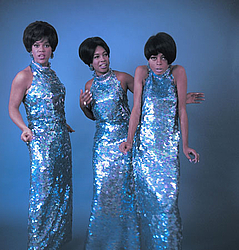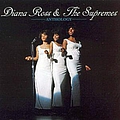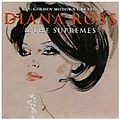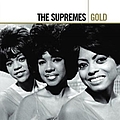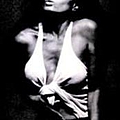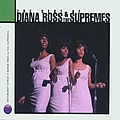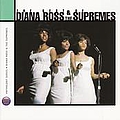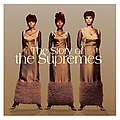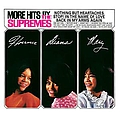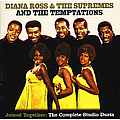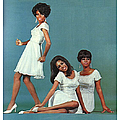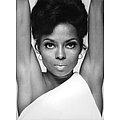Diana Ross & The Supremes Biography
The Supremes, an American female singing group, were the premier act of Motown Records during the 1960s. Originally founded as The Primettes in Detroit, Michigan, in 1959, The Supremes' repertoire included doo-wop, pop, soul, Broadway show tunes, psychedelic soul, and disco. They were the most commercially successful of Motown's acts and are, to date, America's most successful vocal group with 12 number one singles on the Billboard Hot 100. Most of these hits were written and produced by Motown's main songwriting and production team, Holland–Dozier–Holland. At their peak in the mid-1960s, The Supremes rivaled The Beatles in worldwide popularity, and their success made it possible for future African-American R&B and soul musicians to find mainstream success. Founding members Florence Ballard, Mary Wilson, Diana Ross, and Betty McGlown, all from the Brewster-Douglass public housing project in Detroit,[3] formed The Primettes as the sister act to The Primes (with Paul Williams and Eddie Kendricks, who would go on to form The Temptations).[3] Barbara Martin replaced McGlown in 1960, and the group signed with Motown the following year as The Supremes. Martin left the act in early 1962, and Ross, Ballard, and Wilson carried on as a trio. During the mid-1960s, The Supremes achieved mainstream success with Ross as lead singer. In 1967, Motown president Berry Gordy renamed the group Diana Ross & the Supremes, and replaced Ballard with Cindy Birdsong. Ross left to pursue a solo career in 1970 and was replaced by Jean Terrell, at which point the group's name reverted to The Supremes. After 1972, the lineup changed more frequently; Lynda Laurence, Scherrie Payne, and Susaye Greene all became members of the group during the mid-1970s. The Supremes disbanded in 1977 after an 18-year run. The Supremes began by performing hit songs by artists such as Ray Charles and The Drifters at sock hops, social clubs and talent shows around the Detroit area. Receiving additional guidance from group friend and established performer Jesse Greer, the quartet quickly earned a local fan following. The girls crafted an age-appropriate style that was inspired by the collegiate dress of popular doo-wop group Frankie Lymon & the Teenagers; and, for the most part, Ballard, Ross and Wilson performed equal leads on songs. Within a few months, guitarist Marvin Tarplin was added to The Primettes' lineup - a move that helped distinguish the group from Detroit's many other aspiring acts by allowing the girls to sing live as opposed to lip-synch. After winning a prestigious local talent contest, The Primettes' sights were set on making a record. In hopes of getting the group signed to the local upstart Motown label, in 1960 Ross asked an old neighbor, Miracles lead singer Smokey Robinson, to help the group land an audition for Motown executive Berry Gordy, who had already proven himself a capable songwriter. Robinson liked the girls and agreed to help, but he liked their guitarist even more; with The Primettes' permission he hired Tarplin, who became the guitarist for The Miracles. Robinson arranged for The Primettes to audition a cappella for Gordy - but Gordy, feeling the girls too young and inexperienced to be recording artists, encouraged them to return upon graduating from high school. Undaunted, later that year The Primettes recorded a single for Lu Pine Records (a label created just for them) entitled "Tears of Sorrow", which was backed with "Pretty Baby". The single, however, failed to find an audience. Shortly thereafter, McGlown became engaged and left the group. Local youth Barbara Martin was McGlown's quick replacement. Determined to leave an impression on Gordy and join the stable of rising Motown stars, The Primettes frequented his Hitsville, U.S.A. recording studio every day after school. Eventually, they convinced Gordy to allow them to contribute hand claps and background vocals for the songs of other Motown artists including Marvin Gaye and Mary Wells. In January 1961, Gordy finally relented and agreed to sign the girls to his label - but under the condition that they change the name of their group. The Primes had by this time combined with Otis Williams & the Distants and would soon sign to Motown as The Temptations. Gordy gave Ballard a list of names to choose from that included suggestions such as "The Darleens", "The Sweet Ps", "The Melodees", "The Royaltones" and "The Jewelettes". Ballard chose "The Supremes", a name that Ross initially disliked as she felt it too masculine. Nevertheless, on January 15 the group signed with Motown as The Supremes. In the spring of 1962, Martin left the group to start a family. Thus, the newly named Supremes continued as a trio. Between 1961 and 1963, The Supremes released eight singles, none of which charted in the Top 40 positions of the Billboard Hot 100. Jokingly referred to as the "no-hit Supremes" around Motown's Hitsville U.S.A. offices, the group attempted to compensate for their lack of hits by taking on any work available at the studio, including providing hand claps and singing backup for Motown artists such as Marvin Gaye and The Temptations. During these years, all three members took turns singing lead: Wilson favored soft ballads; Ballard favored soulful, hard-driving songs; and Ross favored mainstream pop songs. Most of their early material was written and produced by Berry Gordy or Smokey Robinson. In December 1963, the single "When the Lovelight Starts Shining Through His Eyes" peaked at number 23 on the Billboard Hot 100. "Lovelight" was the first of many Supremes songs written by the Motown songwriting and production team known as Holland–Dozier–Holland. In late 1963, Berry Gordy chose Diana Ross as the official lead singer of the group. Ballard and Wilson were periodically given solos on Supremes albums, and Ballard continued to sing her solo number, "People", in concert for the next two years. In the spring of 1964, The Supremes recorded the single "Where Did Our Love Go." The song was originally intended by Holland-Dozier-Holland for The Marvelettes, who rejected it. Although The Supremes disliked the song, the producers coerced them into recording it. In August 1964, while The Supremes toured as part of Dick Clark's Caravan of Stars, "Where Did Our Love Go" reached number one on the US pop charts, much to the surprise and delight of the group. It was also their first song to appear on the UK pop charts, where it reached number three. "Where Did Our Love Go" was followed by four consecutive US number-one hits: "Baby Love" (which was also a number-one hit in the UK), "Come See About Me", "Stop! In the Name of Love" and "Back in My Arms Again". "Baby Love" was nominated for the 1965 Grammy Award for Best Rhythm & Blues Recording. The Supremes became the first black female performers of the rock era to embrace a more feminine image. Much of this was accomplished at the behest of Motown chief Berry Gordy and Maxine Powell, who ran Motown's in-house finishing school and Artist Development department. Unlike many of her contemporaries, Ross sang in a thin, calm voice, and her vocal styling was matched by having all three women embellish their femininity instead of imitate the qualities of male groups. Eschewing plain appearances and basic dance routines, The Supremes appeared onstage in detailed make-up and high-fashion gowns and wigs, and performed graceful choreography created by Motown choreographer Cholly Atkins. Powell told the group to "be prepared to perform before kings and queens." Gordy wanted The Supremes, like all of his performers, to be equally appealing to black and white audiences, and he sought to erase the image of black performers as being unrefined or lacking class. By 1965, The Supremes were international stars. They toured the world, becoming almost as popular abroad as they were in the US. Almost immediately after their initial number-one hits, they recorded songs for motion picture soundtracks, appeared in the 1965 film Beach Ball, and endorsed dozens of products, at one point having their own brand of bread. By the end of 1966, their number-one hits included "I Hear a Symphony", "You Can't Hurry Love" and "You Keep Me Hangin' On". That year the group also released The Supremes A' Go-Go, which became the first album by an all-female group to reach number one on the US Billboard 200, knocking The Beatles' Revolver out of the top spot.[28] Because The Supremes were popular with white audiences as well as with black ones, Gordy had the group cater to its middle American fan base by grooming the women for performances at renowned supper clubs such as the Copacabana in New York. Broadway and pop standards were incorporated into their repertoire alongside their own hit songs. As a result, The Supremes became one of the first black musical acts to achieve complete and sustained crossover success. Black rock and roll musicians of the 1950s had seen many of their original hit tunes covered by white musicians, with these covers usually achieving more fame and sales success than the originals. The Supremes' success, however, counteracted this trend. Featuring three group members who were marketed for their individual personalities (a move unprecedented at the time) and Diana Ross’s pop-friendly voice, The Supremes broke down racial barriers with rock and roll songs underpinned by R&B stylings. The group became extremely popular both domestically and abroad, becoming one of the first black musical acts to appear regularly on television programs such as Hullabaloo, The Hollywood Palace, The Della Reese Show, and, most notably, The Ed Sullivan Show, on which they made 17 appearances. The Supremes' cross-cultural success effectively paved the way for the mainstream success of contemporaneous label mates such as The Temptations, The Four Tops and The Jackson 5. Personnel problems within the group and within Motown Records' stable of performers led to tension among the members of The Supremes. Many of the other Motown performers, particularly Martha Reeves of Martha and the Vandellas, felt that Berry Gordy was lavishing too much attention upon the group—and upon Ross, in particular. A romantic relationship between Gordy and Ross further complicated matters, and created a schism between Ross and the other Supremes. As Ross became the focal point of The Supremes, Ballard felt pushed aside in the group. Depression ensued, and Ballard began to drink excessively, gaining weight until she could no longer comfortably wear many of her stage outfits. The friendship, and later the working relationship, between Ross and Ballard became strained.[30] During this turbulent period, Ballard relied heavily upon the advice of group mate Mary Wilson, with whom she had maintained a close friendship. Wilson, while outwardly demure and neutral in hopes of keeping the group stable, privately advised Ballard that Ross and Gordy were eager to oust Ballard. Although The Supremes scored two number-one hits during the first quarter of 1967, "Love Is Here and Now You're Gone" and "The Happening", the group as a unit began to disintegrate. Rumors began to circulate in late 1966 that Motown intended to rename the group "Diana Ross & the Supremes", a change officially announced in early 1967, after a concert where they were billed as "The Supremes with Diana Ross". The Miracles had become "Smokey Robinson & the Miracles" two years prior. The fall of 1967 saw Martha & the Vandellas become "Martha Reeves & the Vandellas". Having learned that Ross would receive top billing, David Ruffin lobbied—unsuccessfully—to have the Temptations renamed as "David Ruffin & the Temptations". Although Gordy maintained that the name changes were done so that Motown could demand more money for live bookings (because they would be providing two acts—a lead singer and a group—instead of just one), The Supremes' name change sparked rumors of a possible solo career for Ross, and contributed to the professional and personal dismantling of the group. According to Mark Ribowsky's 2009 book "The Supremes: A Saga of Motown Dreams, Success, and Betrayal", Gordy intended to replace Ross with Barbara Randolph as early as 1966 during a run of live gigs in the autumn of that year, but changed his mind and instead kept Ross in the group for several more years. By 1967, Ballard would sometimes fail to show up for recording dates, or would arrive at shows too inebriated to perform. For some early 1967 shows, she was replaced by Marlene Barrow of Motown's in-house backing group, The Andantes. Gordy contacted Cindy Birdsong in April 1967; she was a member of Patti LaBelle & the Bluebelles and superficially resembled Ballard. Gordy began plans to bring her in as Ballard's replacement. Birdsong appeared at a benefit concert at the Hollywood Bowl on April 29, 1967, but returned to The Bluebelles soon afterward due to prior commitments. In May, Ballard returned for what she believed was a probationary period. Summer 1967 marked the group's first appearance as Diana Ross & the Supremes at the Flamingo Hotel in Las Vegas. After only three days of performances, Ballard was permanently dismissed from The Supremes, and Birdsong officially assumed her place during the second July 1 show. Ballard's release from Motown was made final on February 22, 1968, when she received a one-time payment of $139,804.94 in royalties and earnings. She attempted a solo career with ABC Records, and was forced to formally reject a solo contract offered by Motown as part of her settlement. Ballard's two 1968 singles failed to chart and her solo album was shelved. In 1971, Ballard sued Motown for $8.7 million, claiming that Gordy and Diana Ross had conspired to force her out of the group; the judge ruled in favor of Motown. Ballard eventually sank into poverty and died abruptly on February 22, 1976 from coronary thrombosis at the age of 32. At the time of her death, she had begun to make financial and personal strides and was planning to reinvigorate her solo career. Ross's departure Holland-Dozier-Holland left Motown in early 1968 after a dispute with the label over royalties and profit sharing, and the quality of Motown's output (and Diana Ross & the Supremes' records in particular) began to falter. From "Reflections" in 1967 to "The Weight" in 1969, only six out of the eleven released singles reached the Top 20, and only one of those, 1968's "Love Child", made it to number one. Due to the tension within the group and stringent touring schedules, neither Mary Wilson nor Cindy Birdsong appear on many of these singles; they were replaced on these recordings by session singers such as The Andantes. The changes within the group and their decreasing sales were signs of changes within the music industry. The gospel-based soul of female performers such as Aretha Franklin had eclipsed The Supremes' pop-based sound, which had by now evolved to include more middle-of-the-road material. In a cultural climate now influenced more than ever by countercultural movements such as the Black Panther Party, The Supremes found themselves attacked for not being "black enough", and lost ground in the black music market. In mid-1968, Motown initiated a number of high-profile collaborations for The Supremes with their old colleagues, The Temptations. Besides the fact that both groups had come up together, the pairings made financial sense: The Supremes had a mostly white fanbase, while The Temptations a mostly black fanbase. By 1969, the label began plans for a Diana Ross solo career. A number of candidates—most notably Syreeta Wright—were considered to replace Ross. After seeing 24-year-old Jean Terrell perform with her brother Ernie, Berry Gordy decided on Ross' replacement. Terrell was signed to Motown and began recording the first post-Ross Supremes songs with Wilson and Birdsong during the day, while Wilson and Birdsong toured with Ross at night. At the same time, Ross began to make her first solo recordings. In November 1969, Ross' solo career was publicly announced. "Someday We'll Be Together" was recorded with the intent of releasing it as the first solo single for Diana Ross. Desiring a final Supremes number-one record, Gordy instead had the song released as a Diana Ross & the Supremes single, despite the fact that neither Wilson nor Birdsong sang on the record. "Someday We'll Be Together" hit number one on the American pop charts, becoming not only the Supremes' 12th and final number-one hit, but also the final number-one hit of the 1960s. This single would also mark The Supremes' final television appearance together with Ross, performing on The Ed Sullivan Show on December 21, 1969. The Supremes without Ross made their final appearance altogether on Ed Sullivan on February 15, 1970.
Top Diana Ross & The Supremes Lyrics
Write a comment
What do you think about Diana Ross & The Supremes? Let us know in the comments below!
Top Diana Ross & The Supremes Albums
Similar artists
- The Supremes60s/Soul
- Diana RossPop/Soul
- Martha Reeves & The Vandellas60s/Soul
- The Marvelettes60s/Soul
- Jimmy Ruffin60s/Soul
- The Four Tops60s/Soul
- The Velvelettes60s/Soul
- Mary Wells60s/Soul
